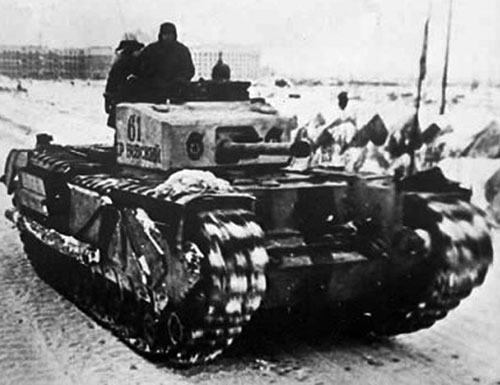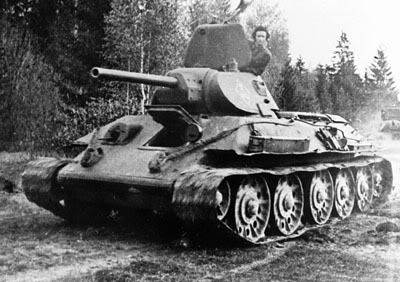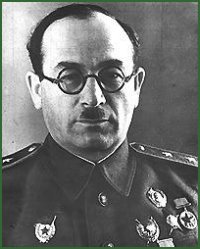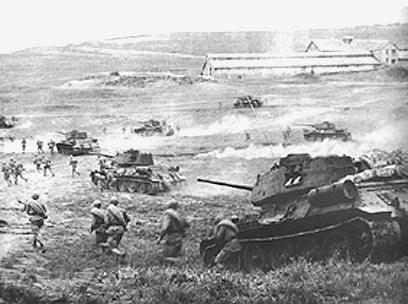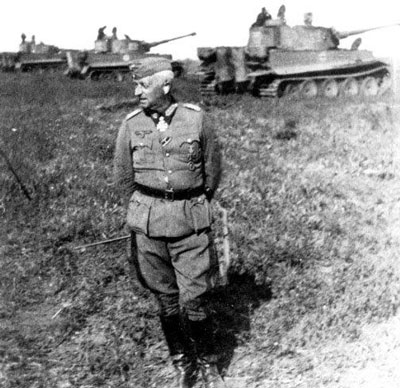Building and painting my Russian Tanks for the Planned Armourgeddon Kursk Event at the Kapiti Wargames Club later this year, and also working on my D-Day and beyond Forces.
Jagdpanthers, Cromwells and ISU-122s in my workbench assmebly line
Jadgdpanthers and Cromwell kits from Armourfast, SU-122 from Italeri. The ISU-122s have the alternate barrels to build the ISU-152 variant too, but the instructions are pretty vague, and don't even mention the ISU-152
Joseph (Iosef) Stalin 2 Tanks (Source Wikipedia)
Italeri models top and die-cast Altaya at bottom, weathered
JS (IS)
The Iosif Stalin tank (IS, in Cyrillic "ИС" tanks, (meaning the Joseph Stalin tank) was a series of heavy tanks developed as a successor to the KV-series by the Soviet Union during World War II. The heavy tank was designed with thick armour to counter the German 88 mm guns, and carried a main gun that was capable of defeating the German Tiger and Panther tanks. It was mainly a breakthrough tank, firing a heavy high-explosive shell that was useful against entrenchments and bunkers. The IS-2 was put into service in April 1944, and was used as a spearhead in the Battle of Berlin by the Red Army in the final stage of the war.
KV1s (Altaya models, repainted and weathered)
KV and IS-1
The Kliment Voroshilov (KV) tanks were a series of Soviet Red Army heavy tanks, named after the Soviet defense commissar and politician Kliment Voroshilov. The KV series were known for their extremely heavy armour protection during the early part of World War II, especially during the first year of the invasion of the Soviet Union.

They were almost completely immune to the 3.7 cm KwK 36 and howitzer-like, short barreled 7.5 cm KwK 37 guns mounted respectively on the early Panzer III and Panzer IV tanks fielded by the invading German forces. Until better guns were developed by the Germans it was often the case that the only way to defeat a KV was with a point-blank shot to the rear.
Prior to the invasion, about 500 of the over 22,000 tanks then in Soviet service were of the KV-1 type. When the KV-1 appeared, it outclassed the French Char B1,the only other heavy tank in operational service in the world at that time. Yet in the end it turned out that there was little sense in producing the expensive KV tanks, as the T-34 medium tank performed better (or at least equally well) in all practical respects. Later in the war, the KV series became a base of development for the Josef Stalin (Iosif Stalin, or IS) series of tanks.

The KV series of Soviet heavy tanks was criticized by its crews for its poor mobility and lack of any heavier armament than the T-34 medium tank. In 1942 this problem was partially addressed by the lighter, faster KV-1S tank. The KV series were much more expensive than the T-34, without having greater combat performance; the heavy tank program was nearly cancelled by Stalin in 1943. However, the German employment of substantial numbers of Panther and Tiger tanks at the Battle of Kursk in 1943 changed Soviet priorities. In response, the Soviet tank industry created the stopgap KV-85, and embarked on the KV-13 design program to create a tank with more advanced armour layout and a more powerful main gun. The IS-85 (Object 237) prototype was initially accepted for production as the IS-1 heavy tank and first deliveries were made in October 1943. Production ended in January 1944.
The lighter KV-1S was released, with thinner armour and a smaller, lower turret in order to reclaim some speed. Importantly, the KV-1S also had a commander's cupola with all-around vision blocks, a first for a Soviet heavy tank. However, the thinning-out of the armor called into question why the tank was being produced at all, when the T-34 could seemingly do everything the KV could do and much more cheaply. The Soviet heavy tank program was close to cancellation in mid-1943.
The appearance of the German Panther tank in the summer of 1943 convinced the Red Army to make a serious upgrade of its tank force for the first time since 1941. Soviet tanks needed bigger guns to take on the growing numbers of Panthers and the few Tigers.
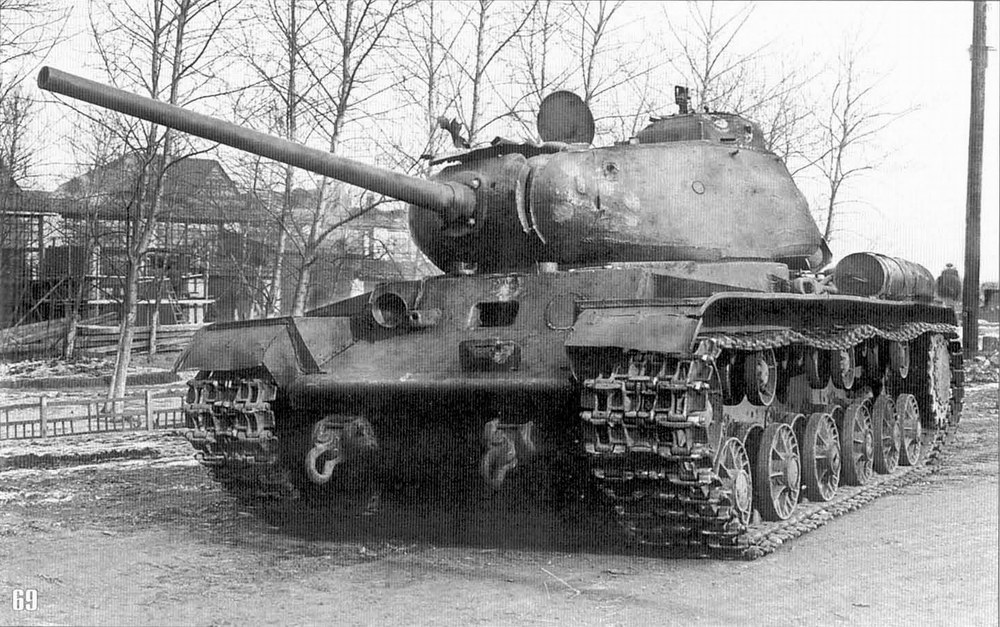
A stopgap upgrade to the KV series was the short-lived KV-85 or Objekt 239. This was a KV-1S with a new turret designed for the IS-85, mounting the same 85 mm D-5T gun as the SU-85 and early versions of the T-34-85; demand for the gun slowed production of the KV-85 tremendously and only 148 were built before the KV design was replaced. The KV-85 was produced in the fall and winter of 1943-44; they were sent to the front as of September 1943 and production of the KV-85 was stopped by the spring of 1944 once the IS-2 entered full scale production.
IS-2
Gun choice
Two candidate weapons were the A-19 122 mm gun and the BS-3 100 mm gun. The BS-3 had superior armour penetration (185 mm compared to 160 mm), but a less useful high explosive round. Also, the BS-3 was a relatively new weapon in short supply, while there was excess production capacity for the A-19 and its ammunition. Compared to the older 76.2 mm tank gun, the A-19 had very good armour penetration, similar to that of the effective 75 mm high velocity gun mounted on the German Panther, and delivered 3.5 times the kinetic energy of the older F-34.

Out with the old and in with the new, IS2 passing the (unpopular) Churchill and Shermans, Stuarts

After testing both BS-3 and A-19 guns, the latter was selected as the main armament of the new tank, primarily because of its ready availability and the effect of its large high-explosive shell when attacking German fortifications. The A-19 used a separate shell and powder charge, resulting in a lower rate of fire and reduced ammunition capacity, both serious disadvantages in tank-to-tank engagements. The gun was very powerful, and while its 122 mm armour-piercing shell had a lower muzzle velocity than similar late-issue German 75 mm and 88 mm guns, Soviet proving-ground tests established that the A-19 could penetrate the front armour of the German Panther tank, and it was therefore considered adequate in the anti-tank role.

German Army data on the penetration ranges of the 122 mm A-19 gun against the Panther tank showed it to be much less effective when the Panther stood at a side angle of 30 degrees to the incoming round: the A-19 gun was unable to penetrate the glacis plate of the Panther at any distance, and could only penetrate the bottom front plate of the hull at 100 m. It was the large HE shell the gun fired which was its main asset, proving highly useful and destructive in the anti-personnel role. The size of its gun continued to plague the IS-2, and the two-piece ammunition was difficult to handle and slow to reload (the rate of fire was only about two rounds per minute). Another limitation imposed by the size of its ammunition was the payload: only 28 rounds could be carried inside the tank
The IS-122 prototype replaced the IS-85, and began mass production as the IS-2. The 85 mm guns could be reserved for the new T-34-85 medium tank, and some of the IS-1s built were rearmed before leaving the factory, and issued as IS-2s.
The main production model was the IS-2, with the powerful A-19. It was slightly lighter and faster than the heaviest KV model 1942 tank, with thicker front armour and a much-improved turret design. The tank could carry thicker armour than the KV series, while remaining lighter, due to the better layout of the armour envelope. The KV's armour was less well-shaped and featured heavy armour even on the rear, while the IS series concentrated its armour at the front. The IS-2 weighed about the same as a German Panther and was lighter than the German heavy Tiger tank series, and was slightly lower than either.
Western observers tended to criticize Soviet tanks for their lack of finish and crude construction. The Soviets responded that it was warranted considering the need for wartime expediency and the typically short battlefield life of their tanks.
Early IS-2s can be identified by the 'stepped' front hull casting with its small, opening driver's visor. The early tanks lacked gun tube travel locks or antiaircraft machine guns, and had narrow mantlets.
Later improved IS-2s (model 1944) had a faster-loading version of the gun, the D25-T with a double-baffle muzzle brake and better fire-control. It also featured a simpler hull front without a 'step' in it (using a flat, sloping glacis armour plate). Some sources called it IS-2m, but it is distinct from the official Soviet designation IS-2M for a 1950s modernization. Other minor upgrades included the addition of a travel lock on the hull rear, wider mantlet, and, on very late models, an antiaircraft machine gun.
SU-122
Soviet High Command became interested in assault guns following the success of German Sturmgeschutz III SPGs. Assault guns had some advantages over tanks with turrets. The lack of a turret made them cheaper to produce. They could be built with a larger fighting compartment and could be fitted with bigger and more powerful weapons on a given chassis. However, assault guns could aim their cannons in high degree only by turning the entire vehicle, and were thus less suited for close combat than tanks with turrets.

The first SU-122s produced in December 1942 were sent to training centers and two new combat units, the 1433rd and 1434th self-propelled artillery regiments. Initially, each of these mixed regiments consisted of two batteries with four SU-122s each and four batteries with four SU-76 tank destroyers each. Each regiment had an additional SU-76 tank destroyer as a command vehicle. It was planned to raise 30 self-propelled artillery regiments operating within armoured and mechanized corps.
In January 1943, the 1433rd and 1434th self-propelled artillery regiments were sent to the Volkhov Front near Leningrad as part of the 54th Army. On 14 January they saw combat for the first time in Smierdny region. After that it was decided SU-122s should follow between 400 m and 600 m behind the attacking tanks; sometimes this distance was shortened to between 200 m and 300 m.
The use of SU-76 tank destroyers together with SU-122s proved unsuccessful. Based on combat experience, the organization of self-propelled artillery regiments was changed; the new regimental organization consisted of two batteries of SU-76 tank destroyers and three of SU-122s, for a total of 20 SPGs. In April the organization of self-propelled artillery regiments was again changed. Separate regiments were created for SU-76 tank destroyers (light self-propelled artillery regiment) and SU-122s (medium self-propelled artillery regiment).
The medium self-propelled artillery regiment consisted of four batteries of four SU-122s each. Each regiment was also equipped with either an additional SU-122 or a T-34 for the commander and a BA-64 armoured car. This organization remained in place until the beginning of 1944 when the SU-122 started to be replaced by the SU-152, ISU-122 and ISU-152 heavy SPGs and SU-85 tank destroyers.

The SU-122 proved effective in its intended role of direct fire on strongholds. The massive concussion of the 122mm HE round was reportedly enough to blow the turret off even a Tiger I if a direct hit was scored at close range, although longer range penetration against heavier German armor remained poor, a trait shared with the larger 152mm howitzers. The new BP-460A HEAT projectile was introduced in May 1943; however its primitive warhead design was only minimally more effective than brute concussive effects of the old HE shell at close range.
At least one SU-122 was captured by the German Army.
ISU-122
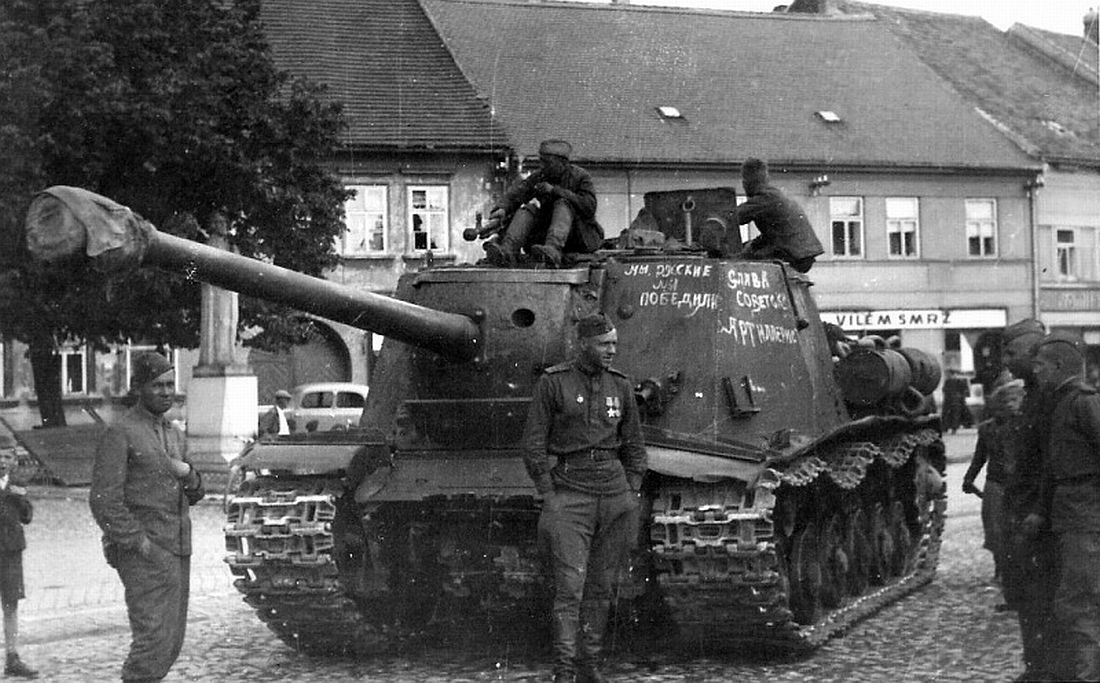
A prototype of the ISU-122 (in Russian ИСУ-122) heavy self-propelled gun was built at the Chelyabinsk Kirov Plant, (Chelyabinskiy Kirovskiy Zavod (ChKZ), Chelyabinsk, Russia), in December 1943. The design shared the chassis of the ISU-152 self-propelled gun and differed only in armament, having an A-19S 121.92-mm gun as its main weapon instead of the ISU-152's ML-20S gun-howitzer. Towed versions of these guns used the same carriage: 52-L-504A (Russian designation 52-Л-504А), so installation of an A-19 instead of an ML-20 gun was not a difficult task. After completing development of the ISU-152, ChKZ engineers mounted the A-19 gun on the ISU-152 chassis to create "Object 242" — the first ISU-122 prototype. It was successfully tested but not immediately launched into mass production.
At that time all ISU hulls were being equipped with the ML-20S gun-howitzer, but the production of hulls increased quickly and there was a lack of ML-20S tubes in the beginning of 1944. State authorities ordered these uncompleted hulls armed with an A-19 gun (specifically with the A-19S variant, slightly modified for the self-propelled gun mount). A further advantage of rearming the ISU was increased direct fire range against heavy German tanks. For these reasons the State Defense Committee adopted Object 242 for Red Army service as the ISU-122 on 12 March 1944. In April 1944 the first series ISU-122 left the ChKZ production lines.
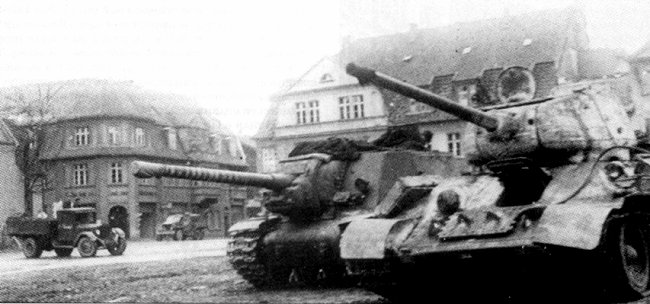
After testing Object 249 was immediately launched in mass production as the ISU-122S (ИСУ-122С) self-propelled gun. However, the original ISU-122 remained in production (along with the ISU-152) due to a large stock of A-19 guns (the ML-20 and D-25 came directly from artillery factories). Mass production of the ISU-122 and ISU-122S ceased at the end of 1945. ChKZ produced 1,735 ISU-122 and 675 ISU-122S variants in total.
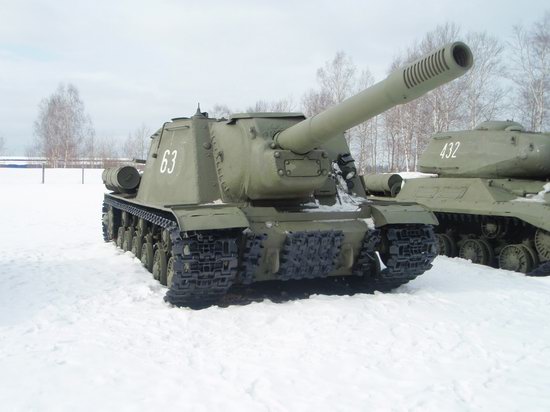
ISU 152































